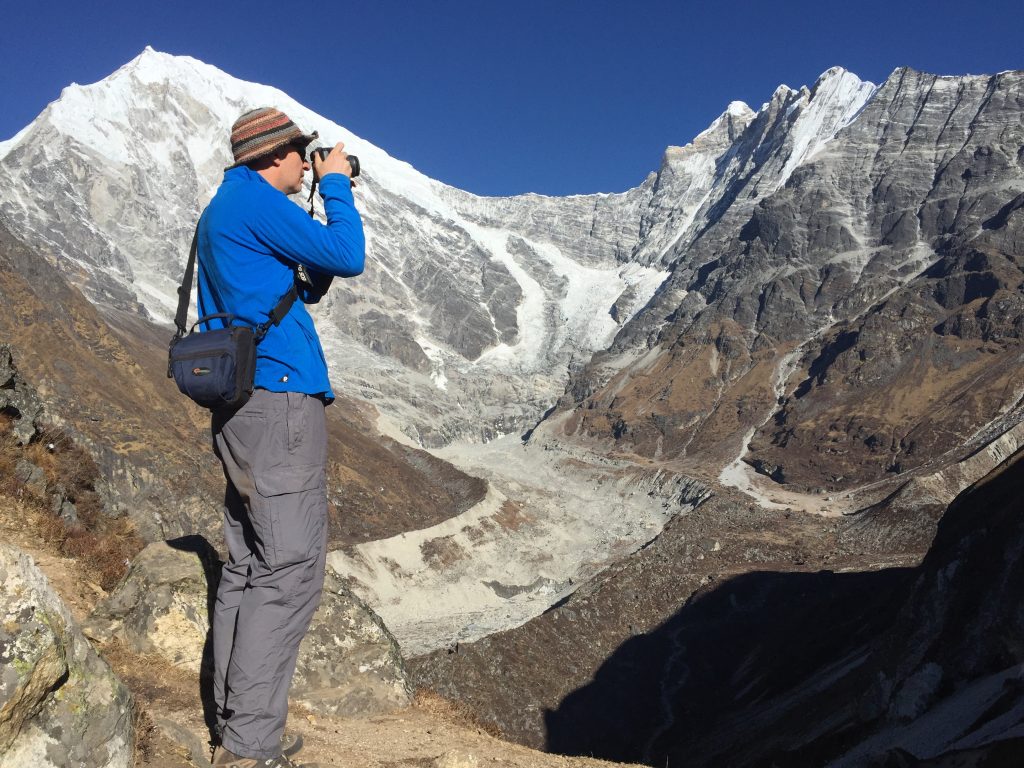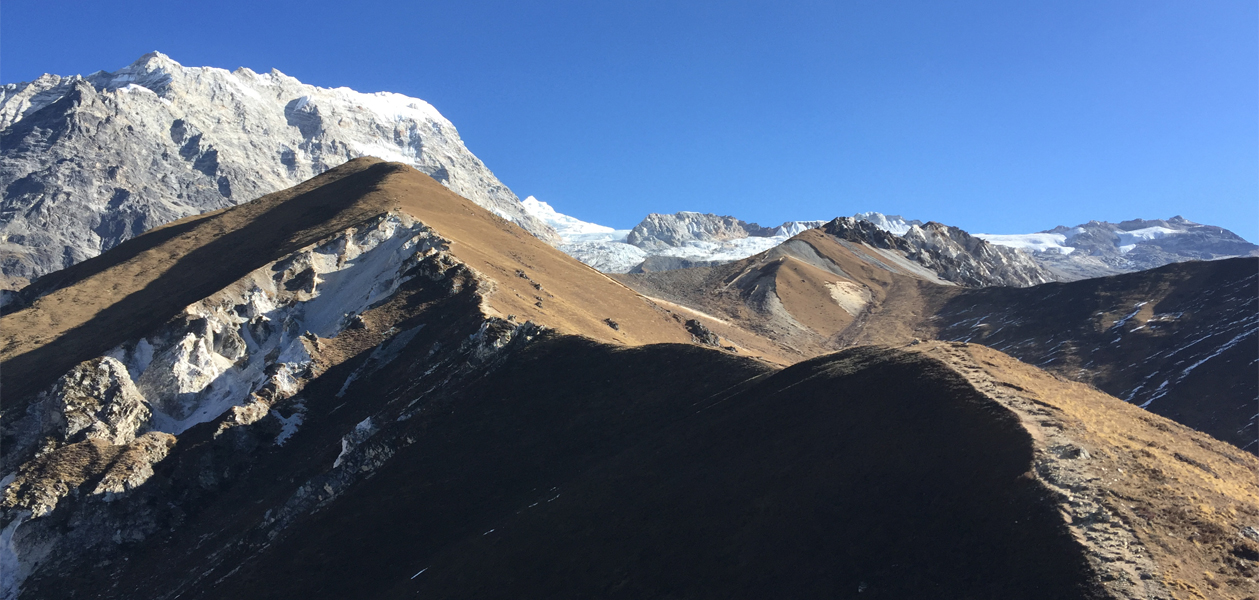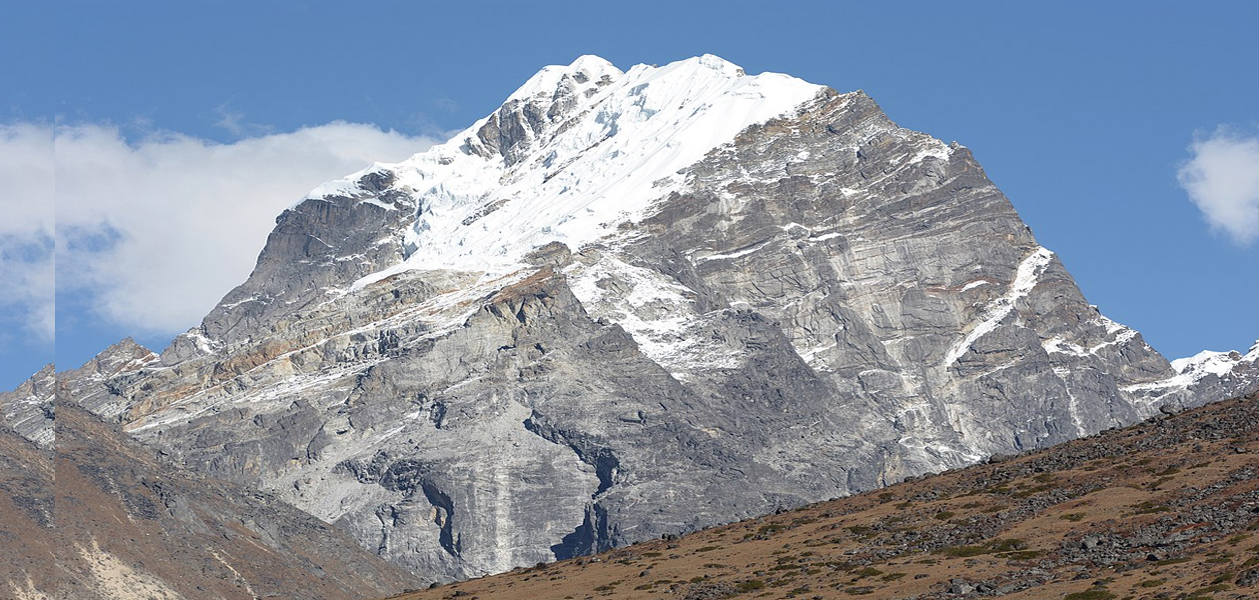Yala Peak Climbing - 15 Days
Best Selling Peak Climbing-
Duration
15 Days
-
Activity
Climbing / Expedition
-
DifficultyChallenging Trek
These treks are the most challenging and require a high level of physical fitness and mountaineering skills. The altitude may go up to 6,000 meters or more, and the terrain can be extremely rugged and steep, with challenging passes and technical sections. These treks often involve mountaineering and require special equipment and permits. Examples of difficult treks in Nepal are the Everest Three Passes Trek, Makalu Base Camp Trek, and the Kanchenjunga Base Camp Trek.
-
Max. Altitude
5033 m
-
Starts
Kathmandu
-
Ends
Kathmandu
-
Group Size
Minimum: 2 pax
-
Best Season
March-May/Sept-Dec
PRICE PER PERSON
- 1 PAX US$1407
- 2 PAX US$1243
- 3 PAX US$1190
- 4 PAX US$1147
- 5-10 PAX US$1112
- 11-20 PAX US$1093
- Highlights
- Itinerary
- Route Map
- What Included / Excluded
- Dates & Availability
- Additional Information
TRIP HIGHLIGHTS
- Breathtaking views of the Langtang Lirung (7,227m), Dorje Lakpa (6,966m), Gangchempo (6,387m), and other neighboring peaks.
- Takes you through beautiful landscapes, dense forests, and scenic valleys.
- Traversing snow slopes and some steep sections, offering a challenging yet achievable experience.
- Experience the warm hospitality of the Himalayan people and learn about their unique customs, traditions, and daily lifestyles.
- Explore villages, lush forests, and the stunning Langtang National Park.
- Explore Kyanjin Gompa (3,870m) and the surrounding areas, visit monasteries, and enjoy the views.
- Yala Peak (5,520m), offers panoramic views of the Langtang mountain range, surrounding peaks, and the vast Himalayan landscape.
- Wonderful trip in the Langtang Valley.
- Opportunity to witness breathtaking golden hues illuminating the snow-capped peaks and the vast Himalayan panorama spreading before you.
Yala Peak Climbing Overview
Yala Peak climbing is a popular adventure activity in Nepal, located in the Langtang region. Yala Peak is situated in the Langtang region, north of Kathmandu, near the border of Tibet. It stands at an altitude of 5,520 meters (18,110 feet). Yala Peak is considered a non-technical trekking peak, suitable for climbers with basic mountaineering skills.

Your journey begins in the vibrant capital city of Nepal, Kathmandu. Spend some time exploring its historic sites, such as Durbar Square and Swayambhunath Stupa, and immerse yourself in the rich cultural heritage of the city. After leaving Kathmandu, you will travel by road to Syabrubesi, the starting point of the Yala Peak climbing expedition. Syabrubesi is a small town situated on the banks of the Bhote Koshi River and serves as the gateway to the Langtang region.
As you trek through the Langtang Valley, you will come across Lama Hotel. It is a picturesque village nestled amidst dense forests and offers a serene setting to rest and recharge before continuing the ascent. Located at an altitude of around 3,430 meters, Langtang Village is a significant stop on the Langtang Valley Trek. It is a traditional Tamang village that was severely affected by the devastating earthquake in 2015. The village is gradually rebuilding, and its resilient spirit and warm hospitality make it a worthwhile place to visit.
Climbers usually take rest days in Kyanjin Gompa (3,870m) to allow their bodies to adjust to the higher altitude. During the rest days, they can explore the surrounding areas, visit monasteries, and enjoy the views. Upon reaching Yala Peak Base Camp (4,800m), climbers set up their camps and prepare for the ascent. This involves checking and adjusting climbing equipment, practicing the use of ice axes and crampons, and receiving instructions from experienced guides.
The summit day typically starts early in the morning, around 2-3 am, to take advantage of stable weather conditions and ensure a safe climb. Climbers make their way up the snow slopes, traversing steep sections, and using proper climbing techniques. The climb can be physically demanding but doesn’t involve technical mountaineering skills.
Reaching the summit of Yala Peak (5,520m) is a rewarding and exhilarating experience. From the top, climbers are treated to panoramic views of the Langtang mountain range, surrounding peaks, and the vast Himalayan landscape. They often take a moment to celebrate their achievement, take photos, and soak in the awe-inspiring scenery.
After enjoying the summit views, climbers descend back to the base camp. From there, they retrace their steps and trek back to Syabrubesi, where the journey concludes. Many climbers take the opportunity to reflect on their experience and appreciate the natural beauty of the Langtang region during the return trek.
Biodiversity:
The Langtang region is known for its rich biodiversity. As you trek towards Yala Peak, you’ll pass through dense forests of rhododendron, oak, pine, and bamboo. The region is home to various wildlife, including Himalayan black bears, red pandas, snow leopards, musk deer, and numerous bird species. The Langtang Valley is also famous for its diverse flora, with colorful alpine flowers blooming during the spring season, including rhododendrons, primroses, and orchids.
Culture:
The Langtang region is predominantly inhabited by the Tamang ethnic group, who have their own unique culture and traditions. As you trek through the local villages, you’ll have the opportunity to experience the warm hospitality of the Tamang people. You can witness their traditional way of life, observe their farming practices, and interact with the locals. Tamang culture is influenced by Tibetan Buddhism, and you may come across monasteries, prayer flags, and chortens (Buddhist shrines) along the way.
Climate:
The climate in the Langtang region, including Yala Peak, varies depending on the season and altitude. Spring (March to May) and autumn (September to November) are considered the best seasons for climbing Yala Peak. During these months, the weather is generally stable, with mild temperatures and clear skies. Daytime temperatures at lower elevations range from 10°C to 20°C (50°F to 68°F), while temperatures at higher altitudes can drop below freezing. However, it’s important to be prepared for temperature fluctuations and possible weather changes, including rain and snowfall, especially at higher elevations.
Difficulty Level:
Yala Peak is considered a non-technical trekking peak, but it still requires a certain level of physical fitness and basic mountaineering skills. The climb involves traversing snow slopes and some steep sections, requiring the use of ice axes, crampons, and rope techniques. Prior trekking experience and familiarity with high-altitude conditions are beneficial. However, with proper acclimatization and guidance from experienced guides, Yala Peak is achievable for climbers with moderate fitness levels.
Duration:
The duration of a Yala Peak climbing expedition typically ranges from 12 to 16 days, depending on the specific itinerary and the pace of the climbers. This duration includes the trek to and from the peak, acclimatization days, and the summit attempt. It’s essential to allow enough time for acclimatization to the high altitude to ensure a safe and successful climb. The duration also provides flexibility in case of unfavorable weather conditions or the need for additional rest days to adjust to the altitude.
Equipments Needed:
Climbing Yala Peak requires specific equipment to ensure safety and comfort during the expedition. Some essential equipment includes mountaineering boots, crampons, ice axes, climbing harness, helmet, ropes, carabiners, quickdraws, ascenders, descenders, prusik cords, trekking poles, warm clothing (layers, down jacket, thermal base layers), a sleeping bag suitable for cold temperatures, sunglasses, sunscreen, headlamp, gloves, gaiters, and a backpack. It’s important to have prior experience using this equipment and ensure that it is in good condition before embarking on the Yala Peak climb. Additionally, a good physical fitness level and basic mountaineering skills are recommended to navigate the technical sections of the climb.
Safety:
Safety is a crucial aspect of any climbing expedition. It is recommended to climb Yala Peak with experienced guides who are knowledgeable about the region and can provide proper guidance. They ensure that climbers follow safety protocols, monitor weather conditions, and make informed decisions regarding the climb. It is essential to pay attention to altitude sickness symptoms and practice responsible mountaineering techniques.
Accommodation:
When you choose “Touch the Himalayas” for your Yala Peak climbing adventure, we will arrange accommodation for you throughout the trek. Along the trekking route, you can expect to stay in teahouses or lodges. These establishments provide basic yet comfortable rooms with twin beds or bunk beds. While the quality and amenities of the accommodations may vary, we generally offer a cozy and warm place to rest after a day of trekking in the mountains.
Meals:
“Touch the Himalayas” ensures that trekkers are provided with meals throughout the climb. We offer three meals a day: breakfast, lunch, and dinner. These meals are typically served in the teahouses or lodges along the trekking route. The food options include a variety of local and international dishes, such as rice, noodles, soups, vegetables, lentils, meat (if available), bread, and tea/coffee. The meals are designed to provide energy and nutrition for trekkers undertaking the challenging climb.
Guides:
When climbing Yala Peak with “Touch the Himalayas,” we provide experienced guides to accompany you throughout the expedition. The guides are knowledgeable about the Yala Peak route, safety protocols, and climbing techniques. We assist with navigation, offer guidance on the technical sections of the climb, and ensure the overall safety and well-being of the climbers. The guides are typically experienced mountaineers with a good understanding of the local terrain and conditions.
Permits:
“Touch the Himalayas” assists trekkers in obtaining the necessary permits for Yala Peak climbing. These permits typically include the Langtang National Park Entry Permit and the Climbing Permit for Yala Peak itself. We handle the paperwork and guide you through the permit application process to ensure all necessary permits are obtained before the expedition begins. These permits are essential to comply with the local regulations and support the conservation efforts in the region.
Itinerary
Welcome at Tribhuvan International Airport, then transfer to your hotel.
Trek preparation and introduce with trekking staffs
Drive from Kathmandu to Syabru Besi
Syabru Bensi to Lama hotel located at altitude of 2480m
Lama hotel to Langtang valley located at altitude of 3541m
Rest at Langtang valley located at 3541m
Langtang valley to Kyangjin Gompa located at altitude of 3900m
Rest at Kyangjing Gompa
Kyangjin Gompa to Yala Base Camp located at 5033 m
Peak climb and back to Kyangjingompa
Kyangjin Gompa to Ghora tabela
Ghora Tabela to Syabru Besi
Syabru Besi to Kathmandu
Rest Day in Kathmandu
Final departure for the airport
Itinerary Note:
This itinerary is just the guide line, it can be changed (longer or shorter) as per our client's wishes, fitness, ground reality and weather condition. If you're not satisfied or have an alternative plan please feel free to discuss it with us By Clicking :- ASK QUESTION or COSTOMIZE YOUR TRIP.What's Included / Excluded
Cost Incluldes
- Airport pick up and drop off by Car, jeep, Hiace or Bus. Depends on the number of arrives.
- Complimentary welcome or farewell dinner according to the suitability of our client’s time.
- Beginning two nights stay on arrival in Kathmandu in tourist standard hotel with breakfast included (twin share basis)
- Internal transport and flight within Nepal as per the itinerary
- All necessary trekking and area permit & fees, (National Park area special permit and TIMs cards).
- OPTIONAL: Three meals a day during the trek (If of required, we provide meal during the trekking)
- OPTIONAL: All accommodation during trek (If of required we arrange all accommodation)
- An experienced, English-speaking, government-licensed, first aid trained trekking guide and assistant guide (5 trekkers: 1 assistant guide)
- An expert local porters (2 trekkers: 1 porter)
- Duffel bag, (to be returned after trip completion), complementary trekking maps. If needed down jacket and sleeping bag will be provided in rent.
- Staff costs including their salary, insurance, Equipment, transport, food and accommodations
- Rescue arrangements if necessary.
- Basic First-aid kit (carried by trekking guide)
- All government and local taxes for Trekking, Agency service charge and government tax/vat.
- Achievement Certificate
Cost Excludes
- International airfare and Nepal visa fee.
- Lunch and Dinner in Kathmandu
- Extra night accommodation in Kathmandu because of early arrival, late departure, early return from mountain (due to any reason) than in the scheduled itinerary
- Personal insurance which covers medical, emergency evacuation, loss or theft of property.
- Personal gears and equipment.
- Personal expenses such as laundry, hot showers, battery charging, Wifi, etc
- Entry fees and costs in sightseeing (temples, monasteries, etc)
- Tips and gratitude provided to guide and porter.
Fixed Departure
Can't find trip as your Schedule Date?
- Above mentioned departure dates “AVILABLE”‘ means these dates are currently open for bookings for the particular Trek. If the mentioned dates are not suitable with your preferred date, you can make your own private trip by clicking the box billow in the bottom.
- A date “GUARANTEED” means that we give guarantees that the costumers will be able to start theirs trek on the specified date, regardless of whether the seats are fully booked or not.
- “LIMITED”‘ Status refers to a type of seats booking for the trek, that has been certain seats available to book
- In the status, “CLOSED” means that the Trekkers seats are fully booked and there are no more seats available for new booking. Trekkers may be put on a waitlist for a chance to get a seat if there are cancellations unless your are requested to plan your own private trip by clicking the box billow in the bottom.
Additional Information
All the trip grading can be view here.
If you have any confusion for booking process please visit our booking process.
















